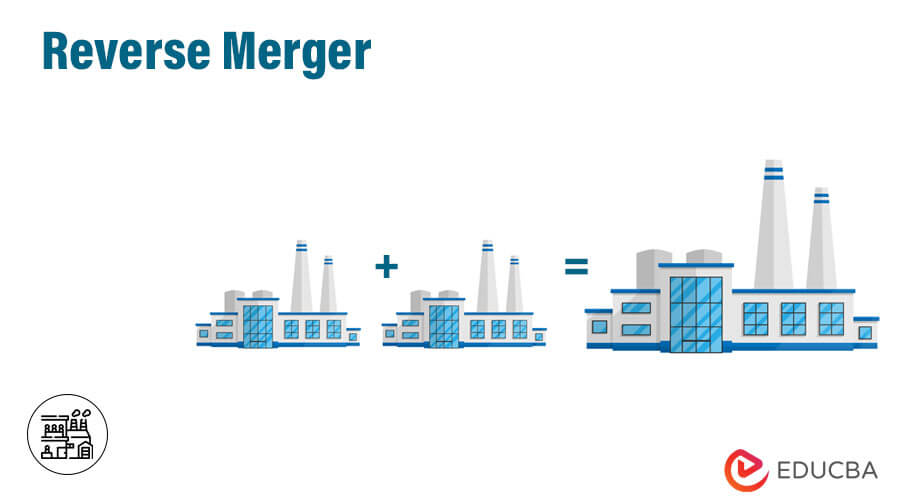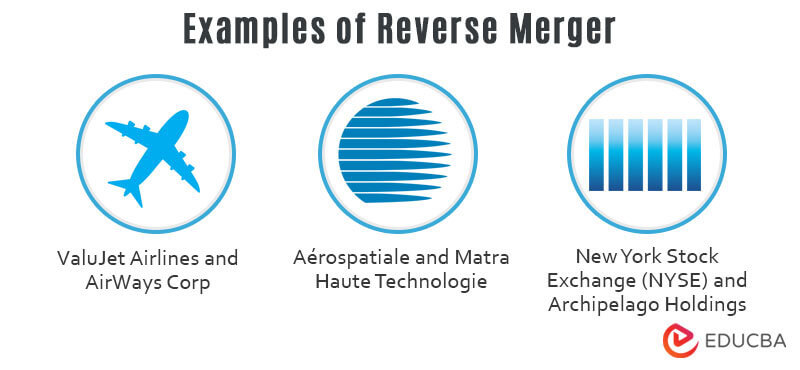Updated July 21, 2023

What is Reverse Merger?
The term “reverse merger” refers to the type of combination of companies wherein the private companies become public either by acquiring the shares of a public company through an exchange share swap or by getting acquired by a public company, thereby effectively becoming its subsidiary. It is also known as Reverse Take Over (RTO) or Reverse Initial Public Offering (Reverse IPO).
Typically, a financially weaker or relatively smaller entity acquires a financially stronger or larger entity. Managers often see the reverse merger as one of the best strategic options for gaining the status of a public company without a much-complicated procedure.
Explanation of Reverse Merger
When a private company intends to become public through the traditional IPO process, then it must comply with many regulations and compliance. On the other hand, it evades such compliance requirements and as such, takes place in a simple, fast, and less expensive way as compared to the conventional IPO. Hence, many companies opt for reverse mergers as they see it as an easy process for converting a private company into a public company.
In a reverse merger, the original shareholders of the private company acquire a majority shareholding in the public shell company, and later it is combined with the acquirer. Typically, financial institutions and investment banks use shell companies to execute these reverse merger deals. In order to be compliant, these shell companies can be simply registered with the concerned authority (for instance Securities and Exchange Commission in the US) as the front end. This registration process is quite easy and less costly.
Examples of Reverse Merger
There are several examples, and some of the major ones have been discussed below:
- ValuJet Airlines and AirWays Corp.: In the year 1997, AirWays Corp. acquired ValuJet Airlines for $62 million stock swap to form the new entity AirTran Holdings. The sole reason for the reverse merger was to leave behind the tarnished reputation of ValuJet Airlines.
- Aérospatiale and Matra Haute Technologie: In the year 1999, Matra Haute Technologie acquired Aérospatiale to form Aérospatiale-Matra, with the intention to take Aérospatiale public.
- New York Stock Exchange (NYSE) and Archipelago Holdings: In the year 2005, NYSE was acquired by Archipelago Holdings in order to form the NYSE Group, and in this way, NYSE, which used to be a mutual company, became public.
Difference Between Merger and Reverse Merger
Some of the major differences between the merger and reverse merger are as follows:
- Intent: The intention of a merger is to combine forces to increase market share, widen product offerings, etc. On the other hand, a reverse merger is carried out to convert an entity from private to the public while saving taxes and time.
- Relative strength of Acquirer: In the case of a merger, the acquirer is financially strong and larger in size. On the other hand, in most reverse mergers, the acquirer is relatively weak financially, with limited to no business.
Advantages and Disadvantages
Below are the advantages and disadvantages:
Advantages
- Efficient Process: The traditional method of going public via IPO typically takes quite a bit of time (maybe a few months or years) for regulatory filings and preparation of the prospectus, while a reverse merger can be executed very fast (within a few weeks). Thus, the process is more efficient than that of a traditional IPO and, as such, saves a lot of time and effort.
- Higher Success Rate: Despite several months of planning, some of the traditional IPOs end up as a failure due to various market scenarios or company-specific issues. However, a reverse merger offers a less complicated and fast process that ensures a higher success rate.
- Lower Market Dependence: The process of reverse merger doesn’t require the promotion of market value to prospective investors in order to raise subscriptions for the upcoming issue, while this is a major concern for traditional IPOs.
- Cheaper Option: In a reverse merger, the companies are not required to pay any hefty fees to the investment bankers, which is otherwise required in case of public issuances. This means that a reverse merger is less costly as compared to a traditional IPO.
- Lucrative Exit: When a private company goes on to become a public company, it offers an excellent exit opportunity for the original promoters. The companies’ shares will now be traded on a public stock exchange and thus would help it gain the advantage of additional liquidity.
Disadvantages
- Information Asymmetry: In most reverse mergers, the process of due diligence is not that extensive, and hence it is overlooked, which might give way to forged letters and bank statements. As such, there is huge scope for information asymmetry due to the lack of procedural transparency.
- Risk of Fraud: In some cases, the acquirer is a small shell or defunct company that either has limited or no underlying business. This exposes the process of reverse merger to huge fraud risk.
- Burden of Compliance: Once a private company goes public, it is obligated to follow various compliance requirements. However, in some cases, it has been seen that the managers are incapable or inexperienced and therefore have no idea about the compliance requirements that come with the status of a public company.
Conclusion
So, it can be seen that reverse merger is a fairly popular strategy for restructuring a business. Reverse mergers also offer benefits to the shareholders along with the company. Despite the fact that the process can be time-consuming, it is important to note that it adds up more value to the business and, in the process, enhances the scope for future sustainability. So, by now, you have a fair bit of an idea about the reverse merger.
Recommended Articles
This is a guide to Reverse Merger. Here we also discuss the introduction and differences between merger and reverse merger, along with the advantages and disadvantages. You may also have a look at the following articles to learn more –


